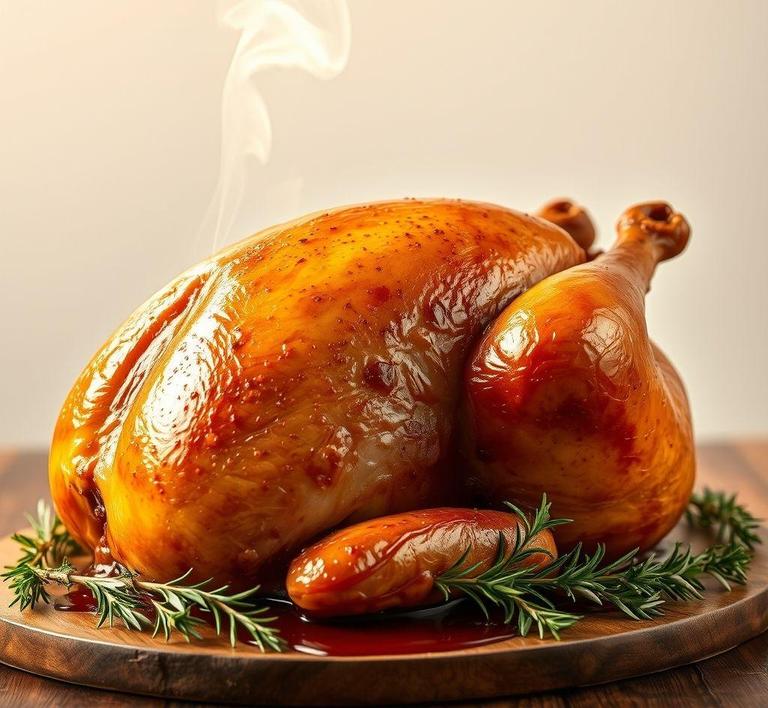Refreezing a fresh turkey might seem like a tricky task, but with the right steps, it’s totally doable! Whether you bought more than you could cook or need to store it for later, properly refreezing your turkey can help preserve its flavor and texture. However, there are a few important things to keep in mind-like ensuring it’s been properly stored and handled before freezing. In this guide, we’ll walk you through everything you need to know about refreezing fresh turkey so you can enjoy it at its best, no matter when you decide to cook it!
Can You Refreeze Fresh Turkey?

Yes, you can refreeze fresh turkey – but with certain conditions. Whether your turkey was bought fresh or thawed after being frozen, refreezing is possible as long as food safety guidelines have been observed. The key lies in temperature control and timing.
If your fresh turkey has been kept at or below 40°F (4°C) – essentially refrigerator temperature – and hasn’t been sitting out for more than two hours (or one hour in temperatures above 90°F/32°C), it can safely be refrozen. However, if the turkey has begun to spoil or has been left at room temperature for too long, refreezing is not just ill-advised – it’s unsafe.
It’s also important to distinguish between a turkey that was initially fresh and one that was previously frozen and thawed. USDA guidelines affirm that raw poultry, once safely thawed in the refrigerator, may be refrozen without cooking. The safety caveat remains the same: refreeze only if the bird has been kept cold and handled properly.
How To Refreeze Fresh Turkey?
Refreezing a turkey isn’t complicated, but doing it correctly is essential for both safety and maintaining some semblance of quality. Here’s a step-by-step guide to ensure your bird is safely returned to a frozen state:
-
Assess the Condition:
Before doing anything, inspect the turkey. If it has any off smell, slimy texture, or discoloration, discard it. Do not attempt to salvage or refreeze meat that may be spoiled.
-
Portion (If Needed):
If you anticipate only needing part of the turkey later, now’s a great time to divide it into usable portions. This not only speeds up future thawing but also minimizes repeated freezing and thawing cycles, which degrade quality.
-
Wrap It Well:
Wrap the turkey tightly in heavy-duty freezer-safe material. Consider a double layer – for example, first wrap it in plastic wrap or freezer paper, then seal it in a freezer bag or vacuum-sealed pouch. This minimizes exposure to air and ice crystals, both of which accelerate freezer burn.
-
Label and Date:
Clearly label your package with the contents and date of refreezing. Turkey can be safely frozen for up to 6 months, although the quality is best if used within 3 to 4 months.
-
Freeze Quickly:
Place the turkey in the coldest part of your freezer, ideally at 0°F (-18°C) or below. Quick freezing slows down the growth of ice crystals that can damage the turkey’s texture.
Quality Impact
While refreezing turkey is safe when done properly, it doesn’t come without consequences. The most notable downside is the impact on texture and moisture content.
Meat contains water, and when it’s frozen, that water forms ice crystals. The first freeze creates crystals that are small if the process is rapid (as with commercial flash freezing) or larger if slow. When thawed, these crystals rupture the muscle fibers. Refreezing the meat after thawing results in a second round of crystallization and rupture. The cumulative effect? A drier, tougher texture when you finally cook the turkey.
Additionally, flavor degradation can occur. Fatty tissues in poultry can oxidize with repeated freezing and thawing, leading to a slightly rancid or ‘off’ taste over time.
To mitigate these effects:
- Refreeze only once.
- Use the refrozen turkey in dishes where texture is less critical (e.g., stews, soups, casseroles).
- Consider marinating the turkey before cooking to restore some moisture and tenderness.
Refreezing fresh turkey is entirely feasible, provided you’ve kept it properly chilled and handled it safely. The main trade-off lies not in safety but in quality. Texture and flavor can suffer due to the destructive effects of ice crystals and fat oxidation during repeated freeze-thaw cycles.
If you anticipate not using your turkey right away – especially with large birds during holiday planning – it’s wise to freeze portions while the meat is still at peak freshness. Done correctly, refreezing can save you money, reduce food waste, and keep you ready for last-minute meals, even if that Thanksgiving turkey has to make a second trip to the freezer.
Always remember: when in doubt, throw it out. Safety trumps salvage every time.
Is It Safe To Refreeze Fresh Turkey?
Yes-but with conditions. Refreezing fresh turkey is generally safe as long as certain food safety guidelines have been strictly followed. The main consideration revolves around whether the turkey has remained at a safe temperature (below 40°F / 4°C) the entire time. If your turkey was thawed in the refrigerator and hasn’t been sitting at room temperature for more than two hours (or one hour if room temperature exceeds 90°F / 32°C), then refreezing is technically safe.
However, safety doesn’t always equate to quality. Each freeze-thaw cycle degrades the meat’s cellular structure. Water within the muscle fibers expands as it freezes and breaks cell walls, resulting in moisture loss upon thawing. The result? Drier, tougher meat. While refreezing won’t necessarily make you sick if handled properly, it can certainly compromise taste and texture.
It’s also important to distinguish between raw and cooked turkey. Cooked turkey holds up better to freezing because it’s already been through structural changes due to heat. On the other hand, raw turkey suffers more from the degradation that comes with repeated freezing and thawing.
Signs That Fresh Turkey Should Not Be Refrozen
Before popping that turkey back into the freezer, a careful inspection is critical. Here are the most telling signs that your turkey has crossed the point of no return:
-
Off-putting Odor:
A sour, sulfurous, or "rotten egg" smell is a clear indication of bacterial activity. Turkey should have a very mild scent or none at all when fresh.
-
Slimy or Sticky Texture:
If the surface of the turkey feels unusually slippery or tacky, bacteria have likely begun to break down the proteins. This is especially concerning if the texture persists after rinsing.
-
Discoloration:
While slight color changes can happen over time in the fridge, gray or green patches or blackened areas are signs of spoilage. Fresh turkey should be pale pink with white fat.
-
Temperature Mismanagement:
If the turkey has been out of refrigeration for more than 2 hours (1 hour in warm climates), it’s entered the ‘danger zone’ (40-140°F), where bacteria multiply rapidly. This makes the meat unsafe for refreezing or even consumption.
-
Ice Crystals or Freezer Burn:
If your turkey has been frozen, thawed, and then begins developing thick ice crystals or white, leathery patches (freezer burn), quality is already compromised. While not harmful, the texture and flavor will suffer.
Common Refreezing Mistakes
Despite best intentions, even the most seasoned home cooks can fall into some common traps. Here are several mistakes to avoid:
-
Refreezing After Thawing at Room Temperature:
Thawing turkey on the counter is never safe. Bacteria grow exponentially at room temperature, especially in large cuts like whole turkeys that thaw unevenly.
-
Repeated Freeze-Thaw Cycles:
Every time you thaw and refreeze, you reduce both the moisture content and structural integrity of the turkey. It’s best to freeze in smaller, portioned amounts to avoid this cycle.
-
Ignoring the "Smell Test":
Trust your senses. A turkey might ‘look fine’ but an unusual odor or sticky feel is a biological warning sign.
-
Freezing in Original Store Packaging:
These packages are typically not airtight and can lead to freezer burn. Instead, wrap the turkey in plastic wrap, followed by aluminum foil or a vacuum-sealed bag for optimal preservation.
-
Storing Too Long:
While frozen turkey can last up to 6 months safely, its quality begins to degrade after 2-3 months. Label packages with the date of freezing and use FIFO (first-in, first-out) to manage stock.
Tips And Tricks
Let’s elevate your food safety game with some expert strategies:
-
Freeze in Portions:
Break down the turkey into smaller cuts-breasts, thighs, wings, etc.-so you can thaw only what you need. This minimizes waste and reduces the temptation to refreeze repeatedly.
-
Flash Freeze Before Long-Term Storage:
Place individual turkey portions on a baking sheet lined with parchment paper and freeze them separately before transferring to a storage bag. This prevents clumping and makes it easy to grab just one piece at a time.
-
Use a Vacuum Sealer:
Oxygen is the enemy of both quality and longevity. Vacuum-sealing not only prevents freezer burn but also extends the safe storage time by limiting microbial activity.
-
Label Clearly:
Include the type of cut, date of freezing, and whether the turkey was raw or cooked. This ensures safe usage and helps in meal planning.
-
Thaw in the Refrigerator:
Never thaw on the counter. The fridge provides a controlled, safe environment where turkey can thaw evenly without entering the bacterial danger zone.
Conclusion
Refreezing fresh turkey isn’t a culinary crime, but it’s a practice that demands careful handling. If the turkey has been thawed safely in the refrigerator and shows no signs of spoilage, refreezing is a viable option-especially if done with an eye on minimizing quality loss. Avoid the pitfalls of poor storage, excessive freeze-thaw cycles, and improper thawing methods, and you can retain not just the safety of your poultry, but also its delicious potential.
Remember: when in doubt, throw it out. Food safety is non-negotiable, and taking risks with poultry can lead to serious consequences. Armed with the right knowledge, though, you can safely and smartly manage your turkey supply with confidence.


